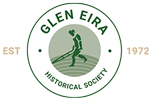By J. O’Donnell, B.A., B.Ed.
The history of most of eastern part of the City of Caulfield is as old as that of the west, and is less obvious to the beholder as few large mansions were erected in the area. Probably the best-known and most ‘romantic’ aspect of its past is the ill-fated Rosstown railway and sugar beet mill built for William Murray Ross.
The lives of the ordinary people however, are also the stuff of which history, and the community, is made. On Saturday afternoon 16 October 1909 ‘a modest weatherboard building, tastefully constructed within pleasing lines and angles and arches and flanked by a small spire, a noticeable feature amongst the houses of the people’ was opened for Congregational Church services. (2)
The story does not begin here though. The church had arrived at the site some time earlier after having been removed from its previous position, cut longitudinally in half, and transported on wagons drawn by great teams of horses. Even in those days, when moving wooden buildings by this means was not uncommon, it was a spectacular sight and a great occasion for the local population. Elderly members of the congregation remember how, as children, they were held up to windows to see the church go by, or watched the procession from the safety of a tree. (5)
The church’s history really begins in 1885 when it was built for the Primitive Methodists on a block of land on the east side of Eastern Road, South Melbourne, south of the Park Street corner. Significant for later events, the site was almost opposite the Wesleyan Church in Park Street. (4) (5)
Unfortunately there is little material which tells us very much about the Primitive Methodists, and even less can be found about their South Melbourne chapel. Although only a minor denomination, the Primitive Methodists appear to have been a flourishing and forward-looking Church, with a number of chapels including one at Brighton (corner of Wilson and Carpenter Streets, built 1851) and missions at most of the Victorian gold-field centres. The Eastern Road church was part of Melbourne First Circuit and opened under the Reverend William Hunt previously of Ballarat. Part of the church reserve was sold, and the church erected on the remainder at a cost of 474 pounds, with another 160 pounds ‘required to finish the surroundings’ three months later. (6)
On 1 January 1902, the Primitive Methodist Church joined with the United Methodists and Wesleyans to form the Methodist Church of Australasia. The little timber chapel in South Melbourne, so close to the much larger and more substantial Wesleyan building in Park Street thus became redundant. Ironically, the chapel survives today, and the Wesleyan building has been overtaken by progress and demolished.
The land for the church in Grange Road was purchased through the gift of 100 pounds by Mr. G. Mercy, and an advance of another 100 pounds resulted in the Congregational Union undertaking the purchase of the ‘very commodious building’ in South Melbourne. (1) (3)
It was a handsome Gothic style building with gabled tower on the left and a circular window above the arched entrance doors. Today, the two halves are held together by metal rods, and the circular window is only visible from the inside. The cutting and removal proved too much for the window’s frame and shortly after the re-erection of the church the window developed a dangerous movement whenever the wind blew. Repairs were impossible, and so the window was kept but covered from the outside by a timber mounted cross. An entrance porch was also added, so the original door and its two small matching windows are hidden from the outside. Apart from these additions, the building is basically in its original condition. (5)
When the church was still ‘new’ in Grange Road, it was possible to see the Rosstown Sugar Mill ‘straight out the back door’. (5) Much of the surrounding area was market gardens which finally disappeared in the post war-building boom experienced in Glen Huntly. Progress caught up earlier with the ‘gas light era’ of the church’s life when it was converted to electricity in 1914. (1) Now the church stands in a brick residential area, a charming reminder of earlier days.
References:
- Trinity Congregational Church Jubilee Booklet
- The Victorian Independent 1909, 1910
- Congregational Year Book 1910
- Directories 1883-1911
- Members of Trinity congregation
- Clarke, Rev. M. History of Primitive Methodism in Victoria and Tasmania
Written by J. O’Donnell, B.A., B.Ed. for The Caulfield Historical Society Newsletter in April 1973.
